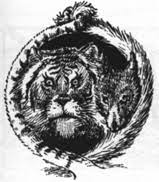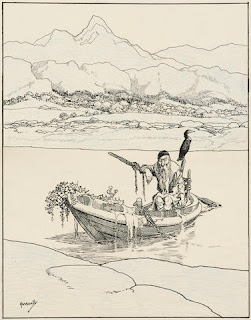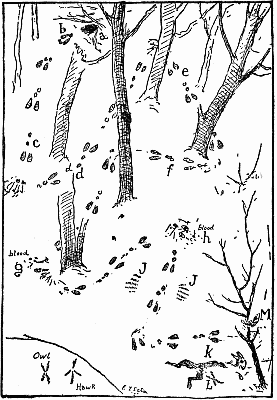In the past I've listed the Lunar New Year as Chinese New Year as that is more familiar here in the U.S. Actually many Asian countries celebrate at the same time. In addition the spread of Covid19 may be linked to the celebration of it in China. Let's not avoid this time of celebration, however you may wish to do it. The Year of the Tiger starts on February 1st of this year. That link lets you explore more about it, but there are so many wonderful stories about tigers, especially from India, that I want to start right away on one I found delightful.
The illustrator of this story, J. Lockwood Kipling, from Flora Annie Steel's Tales of the Punjab is mentioned in my first of two earlier posts by Steel as the father of Rudyard Kipling. At the time I just used the label of Kipling to let me also use it for Rudyard. Have yet to post anything by Rudyard, although I love his Just So Stories! If you've never found a copy, preferably with good illustrations, go to your library or bookstore IMMEDIATELY! In the meantime I've given J. Lockwood's Wikipedia link as he deserves your attention, too.My copy is a newer edition of Tales of the Punjab, but look at the glorious style of the original edition's binding. No dust cover can compare.
I've also commented on the problem of copying many of my books and how I often use a Gutenberg edition. Today's copy came from there, but it must have been from a time when illustrations were omitted and merely noted where they were in the text. I've added them, giving them a bit more attention that way.
One last thing, it's often said that the moral of a story should be left unsaid, letting the audience decide what it is for each person. The moral is stated here. I'm going to give you a chance to think of your own before showing what Steel says it is.
Now for the story and don't let the subtitle, "A Tale of Woe" stop you for it can be rollicking good fun seeing what happens to the tiger.
THE CLOSE ALLIANCE
A TALE OF WOE
One day a farmer went with his bullocks to plough his field. He had just turned the first furrow, when a tiger walked up to him and said, 'Peace be with you, friend! How are you this fine morning?'
'The same to you, my lord, and I am pretty well, thank you!' returned the farmer, quaking with fear, but thinking it wisest to be polite.
'I am glad to hear it,' replied the tiger
cheerfully, 'because
Providence has sent me to eat your two
bullocks. You are a
God-fearing man, I know, so make haste and
unyoke them.'
'My friend, are you sure you are not making a mistake?' asked the farmer, whose courage had returned now that he knew it was merely a question of gobbling up bullocks; 'because Providence sent me to plough this field, and, in order to plough, one must have oxen. Had you not better go and make further inquiries?'
'There is no occasion for delay, and I should be sorry to keep you waiting,' returned the tiger. 'If you'll unyoke the bullocks I'll be ready in a moment.' With that the savage creature fell to sharpening his teeth and claws in a very significant manner.
But the farmer begged and prayed that his oxen might not be eaten, and promised that if the tiger would spare them, he would give in exchange a fine fat young milch cow, which his wife had tied up in the yard at home.
To this the tiger agreed, and, taking the oxen with him, the farmer went sadly homewards. Seeing him return so early from the fields, his wife, who was a stirring, busy woman, called out, 'What! lazybones!—back already, and my work just beginning!'
Then the farmer explained how he had met the tiger, and how to save the bullocks he had promised the milch cow in exchange. At this the wife began to cry, saying, 'A likely story, indeed!—saving your stupid old bullocks at the expense of my beautiful cow! Where will the children get milk? and how can I cook my pottage and collops without butter?'
'All very fine, wife,' retorted the farmer, 'but how can we make bread without corn? and how can you have corn without bullocks to plough the fields? Pottage and collops are very nice, but it is better to do without milk and butter than without bread, so make haste and untie the cow.'
'You great gaby!' wept the wife, 'if you had an ounce of sense in your brain you'd think of some plan to get out of the scrape!'
'Think yourself!' cried the husband, in a rage.
'Very well!' returned the wife; 'but if I do the thinking you must obey orders; I can't do both. Go back to the tiger, and tell him the cow wouldn't come along with you, but that your wife is bringing it'
The farmer, who was a great coward, didn't half like the idea of going back empty-handed to the tiger, but as he could think of no other plan he did as he was bid, and found the beast still sharpening his teeth and claws for very hunger; and when he heard he had to wait still longer for his dinner, he began to prowl about, and lash his tail, and curl his whiskers, in a most terrible manner, causing the poor farmer's knees to knock together with terror.
Now, when the farmer had left the house, his wife went to the stable and saddled the pony; then she put on her husband's best clothes, tied the turban very high, so as to make her look as tall as possible, bestrode the pony, and set off to the field where the tiger was.
She rode along, swaggering and blustering, till she came to where the lane turned into the field, and then she called out, as bold as brass, 'Now, please the powers! I may find a tiger in this place; for I haven't tasted tiger's meat since yesterday, when, as luck would have it, I ate three for breakfast.'
Hearing these words, and seeing the speaker ride boldly at him, the tiger became so alarmed that he turned tail, and bolted into the forest, going away at such a headlong pace that he nearly overturned his own jackal; for tigers always have a jackal of their own, who, as it were, waits at table and clears away the bones.
'My lord! my lord!' cried the jackal, 'whither away so fast?'
'Run! run!' panted the tiger; 'there's the very devil of a horseman in yonder fields, who thinks nothing of eating three tigers for breakfast!'
At this the jackal sniggered in his sleeve. 'My dear lord,' said he, 'the sun has dazzled your eyes! That was no horseman, but only the farmer's wife dressed up as a man!'
'Are you quite sure?' asked the tiger, pausing.
'Quite sure, my lord,' repeated the jackal; 'and if your lordship's eyes had not been dazzled by—ahem!—the sun, your lordship would have seen her pigtail hanging down behind.'
'But you may be mistaken!' persisted the cowardly tiger; 'it was the very devil of a horseman to look at!'
'Who's afraid?' replied the brave jackal. 'Come! don't give up your dinner because of a woman!'
'But you may be bribed to betray me!' argued the tiger, who, like all cowards, was suspicious.
'Let us go together, then!' returned the gallant jackal.
'Nay! but you may take me there and then run away!' insisted the tiger cunningly.
'In that case, let us tie our tails together, and then I can't!' The jackal, you see, was determined not to be done out of his bones.
To this the tiger agreed, and having tied their tails together in a reef-knot, the pair set off arm-in-arm.
Now the farmer and his wife had remained in the field, laughing over the trick she had played on the tiger, when, lo and behold! what should they see but the gallant pair coming back ever so bravely, with their tails tied together.
'Run!' cried the farmer; 'we are lost! we are lost!'
'Nothing of the kind, you great gaby!' answered his wife coolly, 'if you will only stop that noise and be quiet. I can't hear myself speak!'
Then she waited till the pair were within hail, when she called out politely, 'How very kind of you, dear Mr. Jackal, to bring me such a nice fat tiger! I shan't be a moment finishing my share of him, and then you can have the bones.'
At these words the tiger became wild with fright, and, quite forgetting the jackal, and that reef-knot in their tails, he bolted away full tilt, dragging the jackal behind him. Bumpety, bump, bump, over the stones!—crash, scratch, patch, through the briars!
In vain the poor jackal howled and shrieked to the tiger to stop,—the noise behind him only frightened the coward more; and away he went, helter-skelter, hurry-scurry, over hill and dale, till he was nearly dead with fatigue, and the jackal was quite dead from bumps and bruises.
***
I said earlier I would give you a chance to think of your own moral. Here's that original picture of the tiger to give you a moment to draw your own conclusion.
Now do you see why the tiger's portrait is encircled in tails? In the original story it also formed the letter "O" for the opening words of "One day."Here's the offiffiffic'al moral:
Moral
—Don't tie your tail to a coward's.
It's an interesting and good moral, but I bet you thought of something else.
May the Year of the Tiger be good to all of us, certainly better than happened to today's tiger, and have fun reading more stories!
***********
- There are many online resources for Public Domain stories, maybe none for folklore is as ambitious as fellow storyteller, Yoel Perez's database, Yashpeh, the International Folktales Collection. I have long recommended it and continue to do so. He has loaded Stith Thompson's Motif Index into his server as a database so you can search the whole 6 volumes for whatever word or expression you like by pressing one key. http://folkmasa.org/motiv/motif.htm
- You may have noticed I'm no
longer certain Dr. Perez has the largest database, although his
offering the Motif Index certainly qualifies for those of us seeking
specific types of stories. There's another site, FairyTalez
claiming to be the largest, with "over 2000 fairy tales,
folktales, and fables" and they are "fully optimized for
phones, tablets, and PCs", free and presented without ads.
Between those two sites, there is much for story-lovers, but as they say in infomercials, "Wait, there's more!"
- Zalka Csenge Virag - http://multicoloreddiary.blogspot.com doesn't give the actual stories, but her recommendations, working her way through each country on a continent, give excellent ideas for finding new books and stories to love and tell.
You're going to find many of the links on these sites have gone down, BUT go to the Internet Archive Wayback Machine to find some of these old links. Tim's site, for example, is so huge probably updating it would be a full-time job. In the case of Story-Lovers, it's great that Jackie Baldwin set it up to stay online as long as it did after she could no longer maintain it. Possibly searches maintained it. Unfortunately Storytell list member, Papa Joe is on both Tim Sheppard's site and Story-Lovers, but he no longer maintains his old Papa Joe's Traveling Storytelling Show website and his Library (something you want to see!) is now only on the Wayback Machine. It took some patience working back through claims of snapshots but finally in December of 2006 it appears!




















